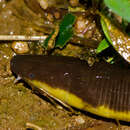Description
provided by AmphibiaWeb articles
Ichthyophis davidi is a large terrestrial caecilian with a nearly cylindrical body (slightly wider than tall). Total length ranges from 268 to 370 mm. The head is somewhat compressed dorsally, with slightly rounded snout. The tentacles are closer to the eye than the nostrils, and are close to the upper lip. The tentacles are thin and long in life, with a yellow dot on the dorsal surface. Many thin, curved, bicuspid teeth are present in the mouth. The collar region is slightly wider than the head. Two collars are present; the posterior collar is longer than the other. Between 321 and 336 annuli are present along the body. The vent runs longitudinally, and is surrounded by a whitish oval-shaped patch. The end of the tail has a hard, knoblike cap (Bhatta et al. 2011). I. davidi can be distinguished from other Ichthyophis species by its large size as it is the largest striped Ichthyophis. Its wider, unbroken lateral stripe curves in at the collar, and is distinct on the lower jaw, extending from the tentacle to the tail. In addition it has large number of annuli (321-336) and large number of splenial teeth (29-40) in its lower jaw.Coloration in life: The dorsum of I. davidi is a metallic chestnut brown color. The snout is slightly lighter than the body. The tentacles are whitish. Ventrally, I. davidi is a light lilac color, darkened at the tail tip. A bright yellow, metallic stripe runs laterally from the tentacle to the tail tip. This band is relatively wide, except for on the lips and at the second collar, where there is an incurvature. Coloration in preservation: The ground color of the dorsum is dark brown, while the venter is light brown. The lateral bands are yellowish. Variation: Annular count ranges from 321 to 336. Number of vomerine teeth ranges from 30 to 60 (Bhatta et al. 2011).The species authorities for I. davidi are Gopalakrishna Bhatta, K. P. Dinesh, P. Prashanth, Nirmal Kulkarni, and C. Radhakrishnan. I. davidi was named after David Gower of the Department of Zoology, The Natural History Museum, London, for his contributions to the study of caecilians in India (Bhatta et al. 2011).
Bhatta, G., Dinesh, K. P., Prashanth, P., Kulkarni, N., and Radhakrishnan, C. (2011). ''A new caecilian Ichthyophis davidi sp. nov. (Gymnophiona: Ichthyophiidae): the largest striped caecilian from the Western Ghats.'' Current Science, 101(8), 1015-1019.
Distribution and Habitat
provided by AmphibiaWeb articles
I. davidi is found in and around Chorla village, Khanapur Taluk, Belgaum District, Karnataka, India. This locality is within the Western Ghats, a mountain range along the west side of India. I. davidi has been found under decaying organic matter in backyards near the type locality (Bhatta et al. 2011).
Life History, Abundance, Activity, and Special Behaviors
provided by AmphibiaWeb articles
The species is rare in and around the type locality, and is not known from elsewhere (Bhatta et al. 2011).
Ichthyophis davidi: Brief Summary
provided by wikipedia EN
Ichthyophis davidi, the Chorla giant striped caecilian, is a new caecilian species of India discovered in Chorla, a village situated on the borders of Goa, Maharashtra, and Karnataka in the Mhadei region of India. It is one of the largest known limbless, yellow-striped caecilians from the Western Ghats. It is named in honour of David Gower, department of zoology, Natural History Museum, London, in recognition of his contributions to Indian caecilian studies. The discovery was made by researchers Gopalakrishna Bhatta of the department of biology, BASE Educational Services Private Limited, Bengaluru; K. P. Dinesh and C. Radhakrishnan of western ghats regional centre, Calicut; P. Prashanth of Agumbe Rainforest Research Station, Agumbe; and Nirmal Kulkarni of Mhadei Research Centre, Chorla Ghat.
- license
- cc-by-sa-3.0
- copyright
- Wikipedia authors and editors

